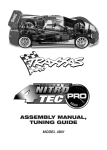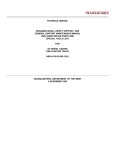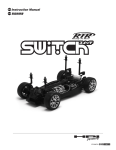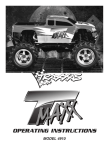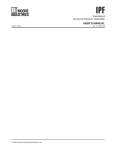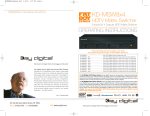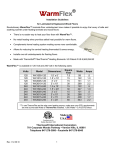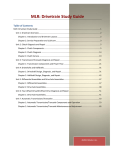Download Traxxas 2401 Motorized Toy Car User Manual
Transcript
MODEL 3701 MODEL 2401 REV 030128 ASSEMBLY MANUAL INTRODUCTION: Below is a list of other tools and supplies you may need for maintenance and repair of your model: Thank you for purchasing a Traxxas product. The Rustler and Bandit deliver pro-level racing technology and performance. The transmission is a quiet and efficient 3-gear design complete with ball bearings. The planetary gear differential provides proven durability and lowmaintenance operation. A slipper clutch is included to prevent tire spin. The four-wheel independent suspension uses oil-filled shocks on the front and rear for extreme amounts of suspension travel and bump absorption. The shocks are fully adjustable so the model will have superb control over rough terrain. Philips screwdrivers, #1 & #2 Flat blade screwdriver (.25 inches wide) Small, flat-blade, jeweler’s screwdriver Pliers, locking (such as Vise Grips) & needle nose Hobby knife Superglue (such as “Zap” brand) Paper plates and Shop rags or paper towels Tape, masking and electrical Machine oil such as “3 in 1” Oil™ This manual details the assembly of both the Rustler and the Bandit. If you purchased a model that is Ready-To-Run, this manual will aid you in disassembling and rebuilding the model during normal maintenance and repair procedures. This manual will also acquaint you with the model’s many different components and its mechanical operation. Paint and other chemicals needed to finish the body are not included. These items can be purchased from your hobby dealer. There is a section in the operating instruction manual which provides tips for painting and detailing the body. Instructions on installing the wing on the Bandit are also included in the operating instruction manual. Look over the manuals and examine the model carefully before opening any of the parts bags included in the kit. If for some reason you think the model is not what you wanted, then do not continue any further. Your hobby dealer absolutely cannot accept a model for return or exchange which has been run or contains open bags. Please read the separate Operating Instructions manual before attempting to drive your new model. If you have any questions about your Rustler or Bandit, call Traxxas’ technical support department at 1-888-TRAXXAS (U.S.A. residents only, outside U.S.A. call 972-265-8000). Technical support is available Monday through Friday, from 8:30am to 9:00pm central time. We hope that you will enjoy your new Traxxas model. Technical assistance is also available thru our website at www.Traxxas.com 24 hours a day. E-mail Traxxas at [email protected] ASSEMBLY HINTS: To assemble this kit, you’ll need a large flat working area where you will have plenty of room to build. Be sure it’s someplace where you can leave your work spread out and not in the way when you want to take a break from the assembly. Allow yourself plenty of time to build this kit, assembly time is going to vary with each individual. Experienced builders may only need 4-5 hours to assemble this kit, while others may spend an entire weekend on it. You should feel comfortable with taking as much time as you need to properly build and set-up your model. The race, after all, is on the track, not the workbench. If you’ve been exploring the contents of your kit box, you’ve noticed many bags of small parts. Open only one bag at a time. To keep the parts organized, use small paper plates or several large plastic plates with partitions to contain the parts. Label the paper plates and then pour the contents of the bags onto them. This puts the parts out in the open where you can find them easily. The plates also prevent small parts from rolling off the table. While it is possible to assemble your kit just by following the pictures, please read the text next to each photo. The text contains important information such as screw sizes and part numbers. Also, pay attention to the “NOTE” which follows some steps. Before you attempt to run your newly-built model, please read all of the instructions and precautions included in the operating instruction manual. Remember, as you assemble your Traxxas model, you are not alone. If you have any questions or run into difficulties, call the Traxxas’ technical support department at 1-888-TRAXXAS (872-9927). Customers outside U.S.A call 972-265-8000. Technical support is available Monday through Friday, from 8:30am to 9:00pm central time. TOOLS YOU WILL NEED: Some of the tools which you may need in the maintenance and repair of your model have been provided for you, they include: Wrenches, 4-way wrench, hex wrenches (1.5mm & 2.0mm) u-joint assembly tool RADIO SYSTEM INSTRUCTIONS: The radio system is not provided in the unassembled kit. Towards the end of the assembly process, there are photos demonstrating a typical, twochannel, radio system installation. Before you begin installing your radio system, it is necessary to locate the center (neutral) position of the steering and throttle servos. Connect the steering servo to the channel 1 terminal and the throttle servo to the channel 2 terminal in the receiver. Connect the thin red and black wires from the mechanical speed control to the “batt” terminal in the receiver. Place fresh “AA” batteries in the transmitter and turn the power switch on. Turn the throttle and steering trim adjustments on the transmitter to the center “0” position. Plug a freshly-charged battery pack into the speed control. The servos will jump to their center position. Now, unplug the battery pack and turn off the transmitter. Disconnect all of the radio components and set them aside. Be careful not to move the servo shafts when installing the servos into your model. IMPORTANT: On the Traxxas mechanical speed control, the red wire is positive and the black wire is negative. Your mechanical speed control is compatible with Futaba and most other brands of radio equipment. However, some brands of receivers have reversed positive and negative input terminals. If you connect the Traxxas speed control to one of these receivers without changing the wiring, the receiver will be severely damaged. Pay particular attention to the wiring when using Airtronics/Sanwa and some Novak brand receivers. Complete instructions for operating the Traxxas TQ radio system are included in the operating instruction manual. However, you will need to follow the instructions that came with your particular radio system. WARRANTY STATEMENT: Every effort has been made in component design and material selection to make your model as durable as possible and still maintain a weight consistent with good handling. Because this model is intended for high-speed operation under severe conditions, no warranties are expressed nor implied relating to the longevity of the parts. If you find that a part has a defect in materials or workmanship, please return it to us BEFORE IT IS USED, and we will gladly replace it. Damage caused by excessive force, abuse, neglect or failure to adhere to the precautions outlined in the literature contained with your model will void the warranty. HARDWARE DESCRIPTION: The drawings that follow are provided to help you identify the many different sizes and types of hardware that are used in the assembly of this model. Note the difference between the length measurements of the roundhead and countersunk screws. A ruler is provided at the bottom of each page to measure the length of the screws in millimeters. 2 Countersunk Machine Screw Washerhead Machine Screw Roundhead Machine screw Shoulder Screw Countersunk Self-tapping Screw Washerhead Self-tapping Screw Roundhead Self-tapping Screw Nylon Locknut Flange Nut Grub Screw 4mm Plastic Bushing 6mm 3mm 3x6x4mm Spacer Aluminum Spacer Plastic Washer Metal Washer 3mm 12mm 3x12mm Countersunk machine screw Teflon Washer Split Washer E-Clip 3mm 12mm 3x12mm Roundhead machine screw 3 Oilite Bushing STEP A-1 This drawing is provided to help you identify the parts of the planetary differential by name. STEP A-2 Locate the main differential gear and one of the sun gears. Apply silicone grease to the base of the output shaft of the sun gear. Insert the sun gear through the center of the main differential gear. OUTPUT SHAFT STEP A-3 Insert the four planet shafts into the holes inside the main differential gear. STEP A-4 Squeeze a small amount of the silicone grease into the center hole of each of the four planet gears. Slide the planet gears onto the planet shafts inside the main differential gear. STEP A-5 Apply grease to the remaining sun gear and the small sun gear alignment shaft. Install the alignment shaft into the center of the first sun gear (inside the differential). Now, install the remaining sun gear over the alignment shaft. 4 STEP A-6 Squeeze a liberal amount of silicone grease inside the main differential gear. Locate the side cover plate. Notice that the two alignment notches, in the side cover plates (arrows) are different sizes. Install the cover plate over the sun gear shaft and onto the main differential gear. Align the notches. Secure the side cover plate with four 2.6x8mm countersunk machine screws located in the machine screw bag. STEP A-7 Locate the top gear shaft, 9.5mm roll pin, the 22-tooth steel top gear and two 5x8x0.5mm teflon washers. Insert the roll pin, bevelled end first, into the hole in one end of the top gear shaft. Use a pair of pliers to carefully squeeze the pin through the shaft until it is centered in the shaft. Be careful not to leave plier marks, or cause other damage to the top gear shaft. NOTE: If the top gear and shaft assembly have been pre-assembled for you at the factory, continue on to step A-9. STEP A-8 Slide the top gear onto the top gear shaft until the notch in the gear fits over the roll pin. Make sure that the roll pin does not protrude far enough on either side to interfere with the gear mesh. Because the top gear press fits onto the shaft, it may be necessary to place the top gear over the open jaws of a vise and use a plastic hammer to tap the shaft through the gear. Do not use a metal hammer for this task, or the shaft may be permanently damaged. STEP A-9 Locate the left and right gearbox halves. Insert a 5x11mm ball bearing into each of the 4 holes in the gearbox. The ball bearings are located in bag H. STEP A-10 Slide a 5x8x0.5mm teflon washer over each end of the top gear shaft. The washers are located in bag H. 5 STEP A-11 Apply a light coating of silicone grease on the teeth of the top gear. Install the top gear shaft into the left gearbox half as shown. STEP A-12 Locate the idler gear shaft and install it into the left gearbox half as shown. Do not grease the ends of the shaft where they insert into the plastic. Slide a 5x8x0.5mm teflon washer over the idler gear shaft. STEP A-13 Locate the idler gear. Press a 5x11mm ball bearing into each side of the gear. Apply a light coating of silicone grease to the gear teeth. STEP A-14 Slide the idler gear over the idler gear shaft, followed by another 5x8x0.5mm teflon washer. STEP A-15 Locate the main-differential assembly. Apply a light coating of grease to the teeth on the gear. Install the differential into the left gearbox housing, pushing the output shaft through the ball bearing. NOTE: The side of the differential with the screws should face down toward the left gearbox half (as shown). 6 STEP A-16 Slide the right gearbox half over the top gear, idler gear, and differential gear shafts. Hold the gearbox halves together tightly with your fingers and spin the top gear shaft to ensure that there is no binding. Slight amounts of roughness will be eliminated after the gearbox has been broken-in from use. STEP A-17 #1 #2 #3 Fasten the gearbox halves together by installing four 3x23mm roundhead machine screws in locations indicated by arrow #1, 3x30mm for arrow #2, and 3x20mm for arrow #3. Do not use an electric screwdriver or overtighten the screws. The two remaining holes in the gearbox will be used later in the assembly process to mount the speed control resistor pack. #1 #1 #1 DRIVE SHAFT ASSEMBLY: STEP A-18 Locate the differential output yokes, and two 3x12 yoke pins. STEP A-19 Press one of the output yokes onto one of the differential output shafts. Align the flat areas inside the yoke with the flat areas on the shaft. Repeat step on the opposite side with the remaining yoke. STEP A-20 Secure both yokes with a 3x12 yoke pin. The shaft of the yoke pin must enter through the hole in the output shaft. Thread the yoke pin into the output yoke until the yoke pin is flush with the outside of the output yoke. 7 STEP A-21 Locate the two external-splined halfshafts, two metal u-joint balls, and the u-joint assembly wrench. External-spline (male) Internal-spline (female) BANDIT: The Bandit halfshafts are shorter than the ones pictured; however, the assembly process is identical. STEP A-22 Begin by inserting one of the pins of the metal u-joint ball into the externalsplined halfshaft. STEP A-23 Use the u-joint assembly wrench, as shown, to insert the opposite pin into the halfshaft. Exert force down and to the left (as shown in the photo), in order to spread both sides of the halfshaft equally by. Repeat for the remaining external-splined halfshaft. STEP A-24 Insert one of the remaining u-joint pins into the differential output yoke. STEP A-25 Use the u-joint assembly wrench to insert the remaining pin into the differential output yoke. Again, spread both sides of the differential output yoke while pressing the pin into the hole. Be careful not to spread the output yoke too far, or breakage could result. Repeat the last two steps for the other side. 8 SLIPPER CLUTCH INSTALLATION: STEP A-26 Locate the 84-tooth spur gear, two pressure plates, two notched, pressure rings, six friction pegs, the spur gear bushing, the slipper tension spring and a 4mm locknut. BANDIT: Use the 78-tooth spur gear instead of the 84-tooth spur gear that is pictured. STEP A-27 Install a pressure plate onto the top gear shaft with the small, gold pin facing out. Place one of the pressure rings over the pressure plate. Install the pressure ring with the flat side against the pressure plate. Align the notch in the pressure ring with the pin. STEP A-28 Slide the spur gear bushing onto the top gear shaft. Install the spur gear. It should fit snugly onto the bushing. Insert a friction peg into every other, inner hole on the spur gear (as shown below). Place the other pressure ring on top of the spur gear (beveled side against the spur gear pegs). STEP A-29 Install the other pressure plate as shown. Align the pin in the pressure plate with the notch in the pressure ring. Slide the spring over the top gear shaft and secure the assembly with the 4mm locknut. MOTOR INSTALLATION: STEP A-30 Locate the motor, two 3x8mm washerhead machine screws, the 18-tooth pinion gear, and a 3mm grub screw. BANDIT: Use the 25-tooth pinion gear instead of the 18-tooth pinion gear that is pictured. 9 STEP A-31 Fasten the motor to the transmission with the two 3x8mm washerhead machine screws. Do not tighten the screws yet. STEP A-32 Slide the pinion gear (teeth first) onto the motor shaft as shown. Insert the grub screw into the pinion gear and tighten it against the flat of the motor shaft with a 1.5mm Allen wrench. STEP A-33 Slide the motor forward so that the pinion gear meshes with the spur gear. Adjust the gear mesh by inserting a piece of thin note paper into the gear mesh and then tightening the motor screws. When the paper is removed, there should be a slight amount of play between the spur gear and the pinion gear. INSTALLING THE GEAR COVER: STEP A-34 Locate the gear cover and two 3x5mm roundhead machine screws. Snap the gear cover over the spur gear and secure it with the two 3x5mm roundhead machine screws. INSTALLING REAR CAMBER LINKS: STEP A-35 Locate the rear shock tower, two 90mm camber links, two 3x12x4mm shoulder screws (the 4mm dimension refers to the length of the shoulder), two 3x12mm roundhead self-tapping screws, and two 3mm flat metal washers. The shoulder screws are located in bag H. Shoulder screw BANDIT: The rear camber links are 65mm overall length. 10 STEP A-36 Fasten the two rear camber links to the lower holes in the shock tower with the 3x12mm shoulder screws and 3x6mm flat washers. Insert the washer between the shoulder screw and the shock tower. STEP A-37 Position the rear shock tower on top of the gearbox as shown. Fasten the shock tower to the gearbox with two 3x12mm roundhead self-tapping screws. The transmission assembly is now complete. REAR SUSPENSION ARMS: STEP B-1 Locate the left and right rear suspension arms, the rear stub axle carriers, two 46mm screw pins, two 28mm screw pins, two 3x12mm ball screws, four 5x8mm oilite bushings, and two 3x6mm flat metal washers. The washers are located in bag H. Remove any mold flashing that may still be attached to the parts. BANDIT: The Bandit rear suspension arms are shorter than the Rustler arms. STEP B-2 “R” Left Right The suspension arms are labeled L and R to designate left and right. Position the left and right suspension arms onto the mounts of the gearbox as shown. Insert a 46mm screw pin through the pivot points on each suspension arm. Tighten the screw pins until they are snug, but not tight enough to bind the suspension arm. Screw pin STEP B-3 Insert the oilite bushings into the stub axle carriers. Place a drop of 3-in-1 Oil™ on each bushing. 11 STEP B-4 Position a stub axle carrier, as shown, on the end of each of the suspension arms. Note that the stub axle carrier has two pivot points. Use the top hole. Insert a 28mm screw pin through the pivot points on each arm. Do not overtighten. Slide a 3x6mm washer over each of the 3x12mm ball screws. Insert the screws into the fourth hole (counting from the inside out) of each rear suspension arm. Washer DRIVE SHAFT COMPLETION: STEP B-5 Locate the two internal-splined halfshafts, the two stub axles, two metal u-joint balls, and the u-joint assembly wrench (leftover from bag A). STEP B-6 Insert one pin of the metal u-joint ball into one side of the internalsplined halfshaft. STEP B-7 Use the u-joint assembly wrench to insert the opposite pin into the halfshaft. Try to exert force down and to the left (as viewed in the photo), in order to spread both sides of the halfshaft yoke equally. STEP B-8 Insert one of the remaining u-joint pins into the stub axle yoke. Use the u-joint assembly wrench to insert the opposite pin into the stub axle yoke. Exert force down and to the left in order to spread both sides of the stub axle yoke equally. 12 STEP B-9 Insert the external-splined halfshaft into the internal-splined halfshaft. Next, insert a greased stub axle through the stub axle carrier. Repeat for the opposite side. STEP B-10 Attach the free end of the camber link to the stub axle carrier with a 3x12mm shoulder screw and a 3x6mm flat metal washer. Repeat for the other stub axle carrier and camber link. The rear suspension is complete. Washer BAG C FRONT SUSPENSION: STEP C-1 Locate the front bulkhead, the front shock tower, and two 3x15mm washerhead self-tapping screws. STEP C-2 Front View Back View Attach the shock tower to the back of the front bulkhead with the two 3x15mm washerhead self-tapping screws. STEP C-3 Locate the two front suspension arms, the left and right caster blocks, two 40mm screw pins, and two 24mm screw pins. Remove any mold flashing that may have remained on the parts. BANDIT: The Bandit front suspension arms are slightly shorter than the Rustler arms. The Bandit also uses two 31.5mm suspension pins with E-clips instead of screw pins. 13 STEP C-4 Attach the front suspension arms to the bulkhead by inserting a 40mm screw pin through each pivot point. Tighten the screw pins until they are snug, but not tight enough to bind the part. STEP C-5 The caster blocks are labeled L and R for left and right. Position the right caster block in the right suspension arm as shown. Insert a 24mm screw pin through the pivot point and tighten. Repeat for the left side. BANDIT: Install the caster blocks with the 31.5mm suspension pins and e-clips. STEP C-6 Locate the steering blocks, four 5x8mm oilite bushings, two 2.5x31.5mm suspension pins, and four e-clips. STEP C-7 Press two 5x8mm oilite bushings into each of the two steering blocks. Snap an e-clip into one of the grooves on each suspension pin. STEP C-8 Position a steering block in the right caster block, as shown. Insert a 2.5x31.5mm suspension pin through the pivot point. Secure the suspension pin by snapping an e-clip into the other groove. Repeat for the other side. 14 STEP C-9 Locate the two 78mm front camber links, four 3x12mm shoulder screws, and four 3x6mm flat metal washers. BANDIT: The front camber links are 75mm overall length. STEP C-10 Attach one end of each camber link to the front shock tower by inserting the 3x12mm shoulder screw through the camber link, sliding a 3x6mm flat metal washer over the shoulder screw, and screwing the shoulder screw into the front shock tower. STEP C-11 Attach the outer end of each camber link to the caster blocks with the remaining two 3x12mm shoulder screws and 3x6mm flat metal washers. Washer STEP C-12 Locate the front bumper and two 4x12mm countersunk machine screws. Attach the front bumper to the bottom of the front bulkhead. The front suspension assembly is now complete. Limiter BAG D SHOCK ASSEMBLY: STEP D-1 Your model is equipped with long front shocks and XX-long rear shocks. Empty the shock parts from bag D onto a plate and separate the parts into like groups. Build only one shock at a time. You will only use the limiter, pictured in the drawing, when building each of the XX-long, rear shocks. The long, front shocks do not require the use of the limiter. 15 STEP D-2 Lubricate a rubber O-ring by putting a drop of silicone oil on it. Push the O-ring into the bottom of the shock body. STEP D-3 Locate the 3x6x2.5mm spacer and remove any mold flashing. Insert the spacer, rounded edge first, into the bottom of the shock body and press firmly so that it compresses the rubber O-ring. STEP D-4 Lubricate another O-ring and insert it into the bottom of the shock body, on top of the spacer. STEP D-5 Secure the seal assembly by screwing the bottom cap onto the bottom of the shock body. Tighten the cap firmly with your fingers only. Do not use pliers to tighten the cap. 3x6x1.5mm Limiter STEP D-6 E-clip Locate the shock rods. Use needle nose pliers to insert an e-clip into the bottom groove on each shock rod. On the two longer rods, slide a 3x6x1.5mm limiter onto each rod. BANDIT: Do not use the limiters in the rear shocks of the Bandit. Instead, use the limiters in the FRONT shocks (on the shorter shock rods). 16 STEP D-7 Place a piston head on the shock shaft. Use the two-hole pistons with the factory-supplied, 40-weight shock oil. Secure the piston head with a small e-clip. STEP D-8 Place a drop of oil on the threads of one of the shock rods (use the longer rods in the longer shock bodies (rear). Insert the rod into the shock body, threaded end first. Move the threads carefully past the seals. STEP D-9 Grip the shock shaft, just above the threads, with the tips of your needlenose pliers and screw on a plastic rod end. Be sure to use the four short rod ends when assembling the shocks. Never grip the shock shaft with pliers any further up on the shaft. STEP D-10 Carefully insert a rubber diaphragm into one of the upper shock caps. The rubber dome should face out (down into the shock). Use the end of the 1.5mm Allen wrench to carefully seat the edges of the diaphragm in the cap. STEP D-11 Pull on the shock rod so that the piston is at the bottom of the cylinder. Fill the shock with oil until it is about 3/4 full. SLOWLY move the piston up and down, while twisting it in the cylinder (always keeping it submerged in oil) to release the air bubbles. Be careful not to squirt oil in your face by moving the piston too rapidly. Finish filling the shock until the oil level is 1.5mm from the top edge of the shock body. 17 STEP D-12 Allow any remaining air bubbles to surface, then screw on the upper shock cap. Tighten the upper cap only finger tight. Overtightening may damage the rubber diaphragm and cause leakage. Exercise the shock. It should operate smoothly and quietly. If it squeaks, remove all trapped air bubbles in the shock body by removing the upper cap and allowing the bubbles to surface and break. STEP D-13 Locate the upper and lower spring retainers, the appropriate length springs (longer for the XX-long rear shocks, shorter for the long front shocks), an assortment of spring pre-load spacers, and two hollow ball connectors (not pictured). STEP D-14 Slide the upper spring retainer over the shock cylinder, followed by the appropriate length spring, and then the lower spring retainer. The spring preload spacers are used to adjust the ride height of the model by inserting them between the upper spring retainer and the upper shock cap. The preload spacers snap over the shock bodies without having to remove the spring. Snap a metal hollow ball connector into the rod ends of the two shorter (long front) shocks (pictured). Repeat steps D-1 through D-15 for the three remaining shocks. BAG E STEERING ASSEMBLY: STEP E-1 Locate the two bellcranks, the drag link, two chrome 3x12mm shoulder bolts, and four 5x8x2.5mm white bushings. Shoulder bolt STEP E-2 Insert the bushings into the top and bottom of the bellcranks by placing the bushing on the table and pressing the bellcrank firmly onto it. You will need to trim any flashing from the bushings and the bellcranks before insertion. The bushings should be flush with the bellcrank. 18 STEP E-3 Attach the drag link to the bellcrank with the two 3x12mm shoulder bolts, as shown. Make sure the assembly operates smoothly without binding. STEP E-4 78mm Locate the two 62mm turnbuckles (tie rods), four long rod ends, and four hollow ball connectors. Screw the rod ends onto the turnbuckles so that each has a center-to-center distance of 78mm. Snap the hollow ball connectors into the rod ends. NOTE: The turnbuckle has reverse threads on the long side. The rod end tightens counter-clockwise on the reverse threads. Reverse threads BANDIT: The center-to-center distance should be 76mm. STEP E-5 Fasten the tie rods to the bellcrank arms, as shown, with two 3x12mm washerhead machine screws. STEP E-6 Locate the upper chassis plate and two 5x8x0.5mm teflon washers. STEP E-7 Turn the upper chassis plate over and slide a 5x8x0.5mm teflon washer over each of the bellcrank pivot posts. 19 STEP E-8 Slide the bellcrank assembly over the posts as shown (note photo for exact assembly). STEP E-9 Locate two 3mm flat washers and two 3x30mm hex cap screws (shown below). Place the washers over the shoulder screws and secure the bellcrank assembly to the posts. STEP E-10 The steering and throttle servos are not included with the kit. Follow your radio system’s instructions for “centering” the servos before installing any servos. Attach the steering servo to the upper chassis plate, exactly as shown, with four 3x8mm washerhead self-tapping screws. STEP E-11 Locate the servo saver and adapters, the 28mm threaded rod, two long rod ends, two hollow ball connectors, one 3x15mm washerhead machine screw, one 3x12mm washerhead machine screw and one 3mm locknut. Adapters Servo Saver STEP E-12 46mm Screw the rod ends onto the threaded rod, an equal number of turns each, so that there is a center-to-center distance of 46mm. Snap the two hollow ball connectors in to the holes on the rod ends. This assembly will now be referred to as the steering rod. 20 STEP E-13 Attach the steering rod to the servo saver with the 3x15mm washerhead machine screw and the 3mm locknut. STEP E-14 Attach the steering rod to the right bellcrank with the 3x12mm washerhead machine screw. STEP E-15 Position the bellcranks so that they are pointing straight ahead, and fasten the servo saver to the servo output shaft. Use the screw size recommended by your radio system instructions to secure the servo saver. Use the correct output shaft adapter when installing the servo saver onto the steering servo. The steering assembly is complete. Check it at this time for smooth operation. BATTERY HOLD DOWN: STEP E-16 Locate the chassis, the battery hold-down plate, the two metal posts, two body clips and speed control mount. STEP E-17 Screw the posts into the chassis as shown. 21 STEP E-18 Place the battery hold-down plate over the posts and secure it with the two body clips. STEP E-19 Position the speed control mount on the chassis as shown. Secure it with two 3x10 washerhead self-tapping screws. RECEIVER: STEP F-1 The receiver is part of the radio system and is not included in the kit. If you are using a Traxxas receiver, fasten the tabs on the receiver to the posts molded in the left side of the chassis. Use two 3x6mm washerhead selftapping screws. Mount all other receivers by using double-sided servo tape. Clean the surfaces of the receiver and the chassis with rubbing alcohol before applying the servo tape. Route the antenna wire under the receiver. STEP F-2 Insert the antenna wire through the antenna tube, and then insert the antenna tube into the slot in the chassis. Do not cut the antenna wire to shorten it. The antenna tube and the antenna tip are in the instruction bag. STEP F-3 Fold the excess antenna wire over the end of the antenna tube and secure it with the antenna tip. 22 OUTPUT SHAFT THROTTLE SERVO: STEP F-4 Locate your throttle servo (not included in the kit) and four 3x8mm washerhead self-tapping screws. Center your throttle servo as described in your radio system’s instructions. Install the throttle servo in the chassis. Position the output shaft as shown and secure the servo with the four 3x8mm washerhead self-tapping screws. Route the throttle servo cable neatly to the receiver and plug the connector into the channel 2 receptacle. TRANSMISSION INSTALLATION: STEP F-5 Locate the transmission assembly, two 3x12mm countersunk self-tapping screws, four 4x12mm countersunk machine screws, and two 3x12mm roundhead self-tapping screws. STEP F-6 Place a piece of electrical or plastic tape over the hole in the bottom of the gearbox. This will prevent dirt from entering. STEP F-7 Position the transmission on the rear of the chassis as shown. Insert two 3x12mm roundhead self-tapping screws, through the bottom of the rear shock tower, into the chassis. STEP F-8 #2 #2 #1 23 Turn the chassis over and insert a 4x12mm countersunk machine screw into each location indicated by the #1 arrows. Insert a 3x12mm counter-sunk selftapping screw into each location indicated by the #2 arrows. SPEED CONTROL: STEP F-9 Locate the rotary mechanical speed control, resistors, resistor cover, two 3x23mm roundhead machine screws, two 3x12mm washerhead self-tapping screws and a 3x12 roundhead self-tapping screw. Remove the speed control from the bag and untangle the wires. In the photo, the speed control is shown in its neutral position (between forward and reverse). It should be in this position when turned over and pressed onto the throttle servo. STEP F-10 Position the speed control on top of the throttle servo and push it down onto the throttle servo output shaft. Secure the speed control with two 3x12mm washerhead screws. NOTE: The servo horn on the speed control is compatible with Traxxas/ Futaba radios. When using other brand radios, use the servo horn which comes with your radio system. STEP F-11 Insert a 3x12mm roundhead self-tapping screw into the shock tower just above the speed control. Do not tighten the screw all the way, as shown. This screw prevents the speed control from lifting off the servo. STEP F-12 Place the two resistors in the aluminum cover, as shown. Fasten the back with a 3x6mm roundhead machine screw and 3mm nylon locking nut STEP F-13 Attach the resistor pack to the top of the transmission with two 3x23mm roundhead machine screws. 24 STEP F-14 Insert the white and blue resistor wires through the square hole in the rear shock tower. Reconnect the wires to the resistor pack. They can be connected in any combination, so long as there is one white and one blue wire per resistor. STEP F-15 Insert the motor wires through the shock tower and connect them to the motor (red-to-red and black-toblack). Route the speed control cable neatly to the receiver and plug the connector into the battery receptacle. FRONT BODY MOUNT: BANDIT: Steps F-16 through F-18 are for the Rustler only. Please skip to Step F-19. STEP F-16 Locate the front body mount, two 25mm body posts, two 3x8mm washerhead self-tapping screws, and two 3x10mm washerhead self-tapping screws. STEP F-17 Fasten the body posts to the body mount with the two 3x8mm washerhead self-tapping screws. Study the photo carefully to ensure correct assembly. STEP F-18 Fasten the body mount to the back of the front shock tower with two 3x10mm washerhead self-tapping screws. 25 FRONT END ASSEMBLY: STEP F-19 Position the front suspension assembly onto the front of the chassis as shown. Attach the front suspension to the chassis with three 4x12mm countersunk machine screws from the underside. STEP F-20 Locate the upper chassis plate assembly, two 4x15mm countersunk machine screws, two 3x12mm washerhead machine screws and two 3x12mm countersunk self-tapping screws. STEP F-21 Position the upper chassis plate assembly on the chassis as shown. Attach it in the front with the two 4x15mm countersunk machine screws and in the rear with the two 3x12mm countersunk self-tapping screws. STEP F-22 Attach the outer ends of the tie rods to the steering blocks with the two 3x12mm washerhead machine screws. SHOCK INSTALLATION: STEP F-23 Locate the two rear XX-long shocks (the two longest ones), two 3x12mm shoulder screws, and two 3x6mm flat metal washers. Insert the shoulder screws through the shock caps and then slide a 3x6mm flat metal washer over the end of each shoulder screw. Screw the shoulder screws into the holes in the shock tower. 26 STEP F-24 Snap the bottom of each rear shock over the ball screws in the rear suspension arms. STEP F-25 Locate the front shocks, the two remaining 3x12mm shoulder screws, two 3x6mm flat metal washers, and two 3x15mm roundhead machine screws. Attach the shocks to the shock tower by inserting the shoulder screws through the shock caps, sliding a 3x6mm flat metal washer over each shoulder screw and screwing the shoulder screws into the front shock tower. STEP F-26 Attach the front shocks to the front suspension arms by inserting the end of each shock into the suspension arm and securing it in the outside holes with 3x15mm roundhead machine screws. BAG G WHEELS, TIRES, AXLES: STEP G-1 Locate the front and rear tires and wheels. The front Rustler wheels can be identified by their deeper offset (dish). Stretch the ribbed front tires over the front wheels and the spiked rear tires over the rear wheels. On all tires, make sure the bead of the tire is fully seated in the groove of the wheel. BANDIT: Stretch the front and rear knobby tires over the front and rear rims, make sure the bead of the tire is fully seated in the rim. You may glue the tires by pulling the bead back with your thumb and placing a drop of superglue in several places around the tire. STEP G-2 Locate two axle pins, hex hubs, 4mm locknuts and 5x8x1.0mm plastic washers. Slide one of the plastic washers over a stub axle. Now, insert the axle pin into the hole in the stub axle. 27 STEP G-3 Slide a hex hub over the stub axle, aligning the stub axle pin with the slots in the hex hub. STEP G-4 Slide a rear wheel over the stub axle, turn until it locks into the wheel. Secure the wheel with a 4mm locknut. Repeat steps G-2 through G-4 for the remaining rear wheel. STEP G-5 Locate the front axles, the remaining two axle pins and hex hubs, two 5x8x0.5mm teflon washers and two 4mm locknuts. BANDIT: The Bandit front axles are shorter than the ones pictured. The Bandit does not require hex hubs in the front. STEP G-6 Liberally coat the front axles with silicon grease. Insert a front axle through the oilite bushings in a steering block. Slide a 5x8x0.5mm teflon washer over the front axle. Insert an axle pin through the hole in the axle. STEP G-7 Slide a hex hub onto the front axle, aligning the axle pin with the slots in the hex hub. BANDIT: Skip to Step G-8. The Bandit does not require the hex hub. 28 STEP G-8 Slide a front wheel over the front axle. Turn until it locks into the front wheel. Secure with a 4mm locknut. Hold the wheel when tightening the locknut. Repeat steps G-6 through G-8 for the remaining front wheel. BANDIT: On the Bandit, use 4mm nylon nuts. CONGRATULATIONS! Your kit is now assembled! All that is left are a few minor details and painting the body. Refer to your “operating instructions” manual to get your model set and ready to drive! 29





























